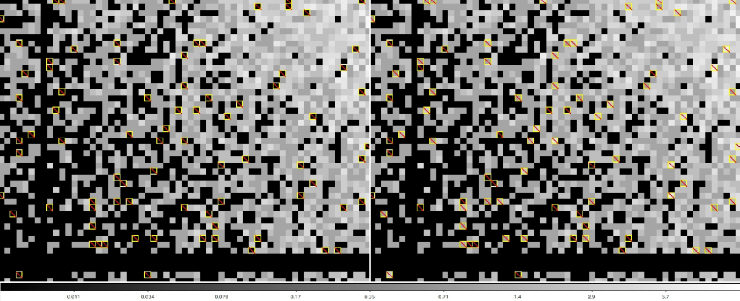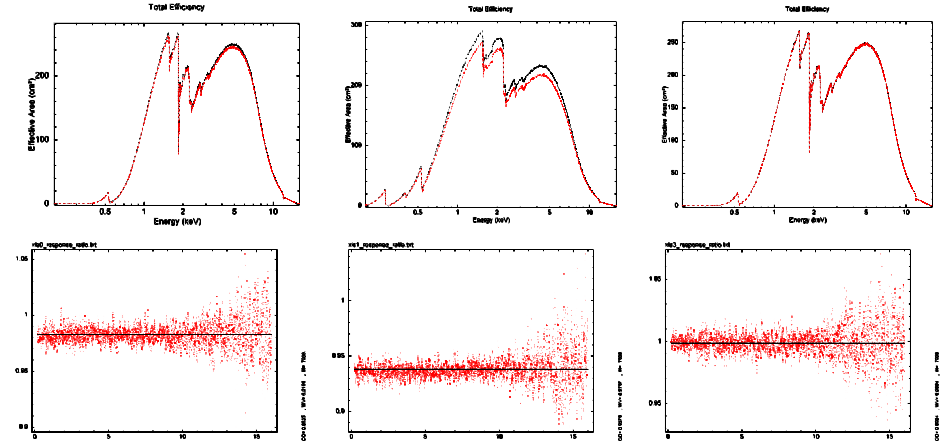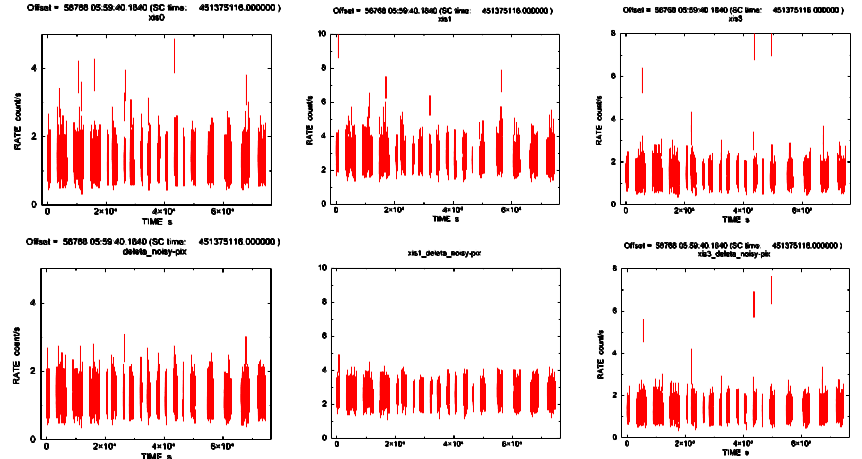A New Recipe for Generating XIS NXB Spectra
Posted on 2016 April 26
A new recipe for generating NXB background spectra.
2015-04-24 by the XIS team
2015-11-30 by the XIS team
2016-03-04 by the XIS team
2015-11-30 by the XIS team
2016-03-04 by the XIS team
Introduction
In the standard processing of the XIS data, flickering pixels are removed.
Flickering pixels are defined as those exceeding a threshold in a given
period of time, thus the number of flickering pixels depends on how long
the data are integrated. For the NXB database, a very long integration time
is used (19 months), whereas individual observations are much shorter.
Because of this, the NXB spectra generated using xisnxbgen are
lower than actual background spectra. This was not a problem in the early
phase of the mission when the fraction of flickering pixels were tiny.
However, as the fraction increased, the discrepancy became noticeable
in the later phase of the mission.
Here, we present a workaround for this problem. A cumulative flickering
pixel map ("noisy pixel map"; the map of the pixels that have
experienced flickering more than once throughout the mission in the past)
is provided in the CALDB. This map should be applied for observation files to
better match the background spectra generated by xisnxbgen at a
sacrifice of an effective area up to 6.5%.
Pros and Cons of this method
- A significant improvement to reproduce the NXB spectra below 1 keV.
- The improvement is larger for newer (later) data.
- The efffective area will be decreased up to about 6.5% by applying this method.
- Users can choose between the conventional method (by default) or the method presented here.
This method is left as an option for users. In general, we recommend this method for weak sources with low surface brightness.
Recipe
Previously,
we
released a method using a region file. With this method, the decrease
in the effective area was not reflected in the ARF files. We thus provide
a revised method as follows.
- For science observation data,
-
Set the flag for the bit 22 of the pixel quality for the event files.
For the definition of pixel quality, see fhelp xisputpixelquality.
> pset xisputpixelquality badcolumfile=ae_xi?_npmsci?_20160128.fits > xisputpixelquality EVENTFILE.evt
The list of selections for ae_xi?_npmsci?_20160128.fits is as
follows. The files are available in CALDB.
-
Remove noisy pixels from an event file and save it into a new file.
This example assumes that only events with no flags above the pixel
quality bit 19 have been selected (i.e., events with the bit 22 flag
have been removed), thus the resultant file does not
include the noisy pixels.
> ftcopy 'EVENTFILE.evt[EVENTS][STATUS=0:524287]' EVENTFILE_NEW.evt -
Produce an ARF file using xissimarfgen, specyfing
the appropriate noisy pixel calibration file.
> pset xissimarfgen badcolumfile=ae_xi?_npmscion_20160128.fits > xissimarfgen instrume=XIS? source_mode=SKYFITS source_image={imagefits} pointing=AUTO num_region=1 region_mode=SKYREG regfile1={regionfile} arffile1={arffile} limit_mode=MIXED num_photon=100000 accuracy=0.005 phafile={phafile} detmask={calmask} gtifile={eventfile} attitude={attfile} rmffile={rmffile} estepfile=default
CI off CI on (2 keV) CI on (6 keV) XIS0 ae_xi0_npmsciof_20160128.fits.gz n/a ae_xi0_npmscion_20160128.fits.gz XIS1 ae_xi1_npmsciof_20160128.fits.gz ae_xi1_npmscion_20160128.fits.gz ae_xi1_npmsci6_20160128.fits.gz XIS2 ae_xi2_npmsciof_20160128.fits.gz n/a n/a XIS3 ae_xi3_npmsciof_20160128.fits.gz n/a ae_xi3_npmscion_20160128.fits.gz -
Set the flag for the bit 22 of the pixel quality for the event files.
For the definition of pixel quality, see fhelp xisputpixelquality.
- For background data by the NXB database,
-
Set the flag for the bit 22 of the pixel quality for a selected NXB
event file in the CALDB.
> pset xisputpixelquality badcolumfile=ae_xi?_npmsci?_20160128.fits > xisputpixelquality ae_xis?_nxbsci?_${DATE}.fits -
Remove noisy pixels from an event file and save it into a new file.
This example assumes that only events with no flags above the pixel
quality bit 19 have been selected (i.e., events with the bit 22 flag
have been removed), thus the resultant file does not
include the noisy pixels.
> ftcopy 'ae_xis?_nxbsci?_${DATE}.fits[EVENTS][STATUS=0:524287]' ae_xis?_nxbsci?_${DATE}_rejectnpm.fits -
Specify the output of the above as the input event file for
xisnxbgen
> pset xisnxbgen nxbevent=ae_xis?_nxbsci?_${DATE}_rejectnpm.fitsthen run xisnxbgen.
-
Set the flag for the bit 22 of the pixel quality for a selected NXB
event file in the CALDB.
Demonstration
Below, some comparisons are shown between the NXB spectra before and after applying the method described above.
- A sample image of before (right) and after (left) removing noisy pixels shown with a square with a red slash.
- A sample spectrum of before (black) and after (red) removing noisy pixels for XIS0 (left), XIS1 (middle), and XIS3 (right).
- A sample ARF effective area before (black) and after (red) removing noisy pixels for XIS0 (left), XIS1 (middle), and XIS3 (right). The bottom panels show the ratio between the effective area before and after applying the method.
- A sample of light curves before (top) and after (bottom) removing noisy pixels for XIS0 (left), XIS1 (middle), and XIS3 (right). Some anomalous bins are removed by applying the noisy pixel removal.




If you have any questions concerning Suzaku, visit the Feedback form.

